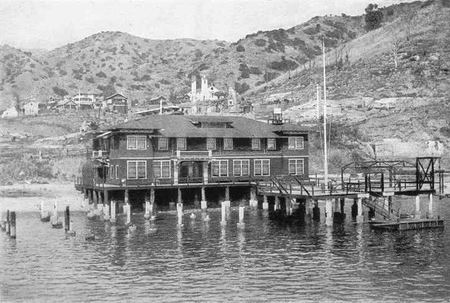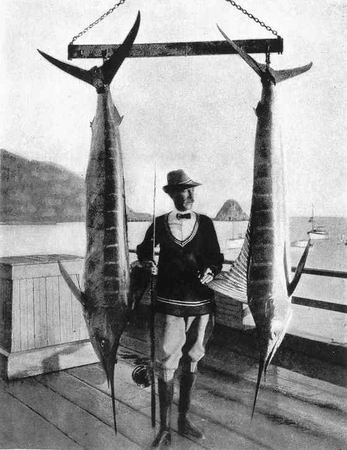|
1999-2003 (Return to Web Text-ures) |
Click Here to return to |
|
1999-2003 (Return to Web Text-ures) |
Click Here to return to |
XVII
SANTA CATALINA ISLAND
THE fishing season of 1917 at Catalina Island was a most successful one. Great schools of tuna made their appearance and afforded much sport. Three hundred and sixty-two tuna were taken during the season and the largest fish weighed 136¼ pounds.
Mr. Boschen landed 13 fish weighing 985 pounds in one day’s fishing.
Fishing with the assistance of a kite was thoroughly tested by two sportsmen who fished side by side for some weeks in the same boat. One trolled in the usual manner and the other used a kite when the wind served. The former did not have a single strike while the latter landed 33 tuna.
On light-tackle nine-thread line, the largest tuna taken weighed 66 pounds, but the greatest feat was performed by Mr. J. W. Jump, who landed a 57-pound tuna in 30 minutes with a six-ounce rod and a six-thread line.
The swordfish record was broken by Mr. Parsons, who captured a swordfish weighing 422 pounds after a battle of over six hours. This record was broken later when Mr. Boschen brought a fish home that weighed 463 pounds. This fish succumbed after a fight that lasted but one hour and a half, which fact was explained by a post-mortem examination which showed that the bait had been gorged and that during the struggle the fish’s heart had been torn by the hook which had caused an internal hemorrhage and death.
I visited San Clemente and was again greatly impressed by the agility of the spearfish.
Although they did not arrive off the island until late in September, they afforded great sport. There were seventy-two spearfish taken under Club Rules, sixteen fish being taken by one boat in four days’ fishing.

TUNA CLUB HOUSE
Avalon
RECORD SWORDFISH
463 pounds
MR. W. C. BOSCHEN
Mr. Pollitz landed the largest spearfish of the season — 326 pounds. This fish jumped forty eight times and fought for one hour and forty minutes.
I discovered that these high and lofty jumping fish take so much out of themselves by their exertions that if you can persuade your boatman to go to them after their acrobatic performance is over, they can then and there be safely gaffed. In this manner I landed a fish that weighed 180 pounds in twenty minutes. This fish had jumped thirty-five times and was exhausted.
There were several spearfish taken by Mr. Jump on light tackle, a nine-thread line and
a six-ounce tip; the heaviest fish weighed 185 pounds.
It is a strange fact that sea-fish fight less and lead more readily on light tackle than if you fight them hard with heavy tackle. The harder you fight them, the harder they seem to fight back.
The chief trouble with light tackle for spearfish is to induce the boatman to follow the fish so that the line from the fish to the rod leads straight, and not by cutting corners attempt to gain on the spearfish, for in the latter course the line bags and will not stand the strain of being pulled sideways through the water.
It is difficult to persuade the boatman in the excitement of the moment to manoeuvre his launch in the opposite direction to that in which the fish is travelling, although it is the only way to straighten the line and remove the strain on the slack that is being pulled through the water faster than it can be reeled in.
Light tackle is all very well with a free. jumping fish, but one that is foul-hooked, seldom jumps and fights like a shark, in which case it becomes a difficult proposition for a light rod and line.
A success with light tackle depends on when and in what waters the fishing is done. At Catalina it is generally safe to decide what weight of fish you will fish for without being surprised by a mackerel shark or a fifty-pound amberjack, as often happens in Florida.

SPEARFISH OR MARLIN
179 and 132 pounds
In the latter case light tackle would be of no more service than it would be at Catalina if one-hundred-and-fifty-pound tuna were taking freely.
The charm of fishing in the waters of the Channel Islands of California is the fact that the tuna and yellowtail run in schools of an average weight, and a fisherman may suit his tackle to the fish that are running at the time.
1918
THAT season was in some respects even better than that of 1917.
No swordfish (Xiphias gladius) were taken and few were seen.
One hundred and fifty-three spearfish (Tetrapturus mitsukurii) were weighed in.
Twelve weighed over 200 pounds each, the largest 328 pounds and the smallest 66 pounds.
Six hundred and thirty nine tuna were landed, 19 of which weighed over 100 pounds each, while the largest fish tipped the scales at 149½ pounds.
Nineteen dolphin were brought in one day and the best day for yellowtail yielded 290 fish.
All these fish were either consumed at Avalon or sent to the market at San Pedro.
1919
THIS was a great tuna year. There were 911 tuna taken during the season, 42 of which were over 100 pounds in weight.
The heaviest fish weighed 1523/4 pounds. Mr. James W. Jump broke the light tackle record by landing a tuna weighing 145½ pounds.
No swordfish (Xipias gladius) were taken during the season.
One hundred and fourteen marlin or spearfish (Tetrapturis mitsukurii) were brought to the scales, 16 of which weighed over 200 pounds. The heaviest fish was taken by Mr. A. W. Hooper and weighed 298 pounds.
I was fortunate enough to land six
spearfish in fifteen days that averaged 207½ pounds.
1920
THERE were 548 tuna taken during the season, 89 of which were over 100 pounds in weight.
The heaviest fish weighed 156 ¾ pounds.
Three swordfish (Xipias gladius) were landed, the heaviest fish weighed 418 pounds.
160 marlin or spearfish (Tetrapturis mitsukurii) were brought to the scales, 6 weighed over 300 pounds and 22 over 200 pounds. Mr. J. A. Coxe landed the record marlin of 372 pounds.
Click
here to continue to the next chapter of
Some Fish and Some Fishing